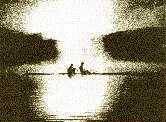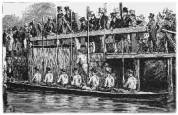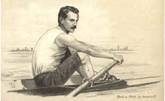Lakeside History (mexican rowing history)
|
|
|
|
The history of Lakeside
Rowing Club is closely to the mexican rowing history. In the second half of XIX
century, during General Porfirio Díaz governement, it was an inmigration of
english enginneers to |
|
|
Thomas Phillips was born in
Thomas Phillips was
fascinated for rowing, so people began to name him "Lakeside" that
origines the name of the Lakeside Rowing Club AC., not only the first rowing
club but the first sport club in The Lakeside Rowing Club
was first established in Ayotla town, at the shore of the |
||
|
When In 1893, was founded the
"Veracruzanos Ruderverein" in the City of |
|
|
|
|
By the year of In 1912, the Lakeside
Rowing Club changed its name to the "British Boating Club". In the
next year was founded the first Rowing Asociation in |
|
In 1914, the Rowing
Asociation of Regattas organizes the first International Regatta, followed
for other regattas, until Mexican Revolution and First World War interrupted
them. By 1924, it was founded the
rowing extention of "Real Club España " (Today Club España, Rowing
Section). |
|
The British Boating Club recovers
its original name of Lakeside Rowing Club in 1961. The Mexican Association of
Regattas change its name definitively to "Federación Mexicana de Remo,
A.C." (Mexican Rowing Federation). By this year, the problems of
|
|
The Lakeside Rowing Club
was absent in the mexican panorama for some years until the force and
enthusiasm of some veteran fellows, leadered by Pat O'Hea and Antony Enyedy,
who lived the rowing glory years at the 1950's, revived it for continue with
the Legend of the First Mexican Rowing Club. Thus Lakeside Rowing Club
has been followed its activities without any interrumption since 1990. Today, the club has
different sections for rowing lovers: kids, teens, novats, begginers,
juniors, seniors and masters for national and international regattas
competition, and for recreation. The rowing kinds, practiced
in the club are: skiff (single scull), double scull, two oars without cox,
quadruple scull, four oars with and without cox, eight oars with cox and
indoor rowing. |
|
|
ROWING
SPORT HISTORY TopG
There is not any evidence of
the rowing practice as a sport or hobby, before the XVIII century. The oldest
sport regattas taked place in the
|
|
The oldest rowing school
club was founded in In the half of XIX century,
rowing became a very popular sport in Europe, |
|
|
In 1873, In In 1888, by the influence
of english enginneers to |
|
|
|
|
In 1892, the
"Federation Internationale des Societes d'Aviron" (FISA) was
founded in |
||
|
By 1896, Pierre de Coubertin
organizes the first Olympic Games of the modern epoch, in |
|
||
|
|
In the Olympic Games of
Paris, 1900, it was included 6 rowing competitions, and by this time, all the
conditions were good and there was not any problem for the regattas. In 1913, it was founded the
first Mexican Rowing Association, "Asociación de Regatas de México"
(Today Federación Mexicana de Remo, FMR). When First World War
happened, most of rowing clubs suspended its regattas, till the war was
finished. In the Olympic Games of Germany, 1936, the german oarsmen won most
of rowing medals. During Second Word War, the regattas were suspended for
second time games. |
||
During the Olympic Games in
|
|
The first regatta for
oarswomen was in In 1956, |
In 1965 the first regatta
"Head of the Charles" was organized in
|
In 1968, the Olympic Games
take place in The Olympic Rowing and
Canoing Course "Virgilio Uribe",
was constructed for the olympic competitions. The fellows of Lakeside
Rowing Club were the more enthusiasthic for this construction. The course was
the better artificial course in that epoch until the end of 1980's. Unfortunately, in the
recent years the course and buildings are deteriorated for a very little
interest of the mexican authorities. |
México
68 El bote 8+ de Australia, que ganó medalla de plata, es hoy "Don
Patricio" (prop. Club Lakeside) |
The Olympic Games of
Montreal, 1976, included the first rowing competition for women.
In 1981 the indoor rowing was
popularized with the ergometer, introduced by the Concept II company and became
an esential part for the oarsmen training in all the world.
The Olympic Games of Atlanta,
1996, included the first rowing competitions for light weight men and women.
Mexican rowing celebrated 100
years old of existence in1988.
1988
In the next Olympic Games of
Beijing, 2008, it will included the first rowing competitions for people with
different habilities.
|
|
Top
Main












